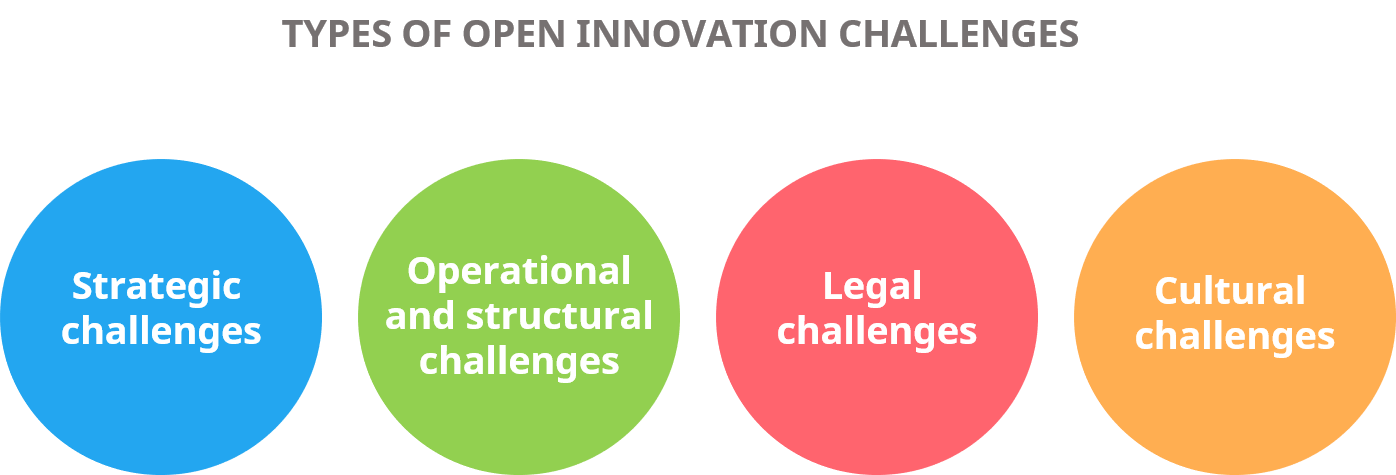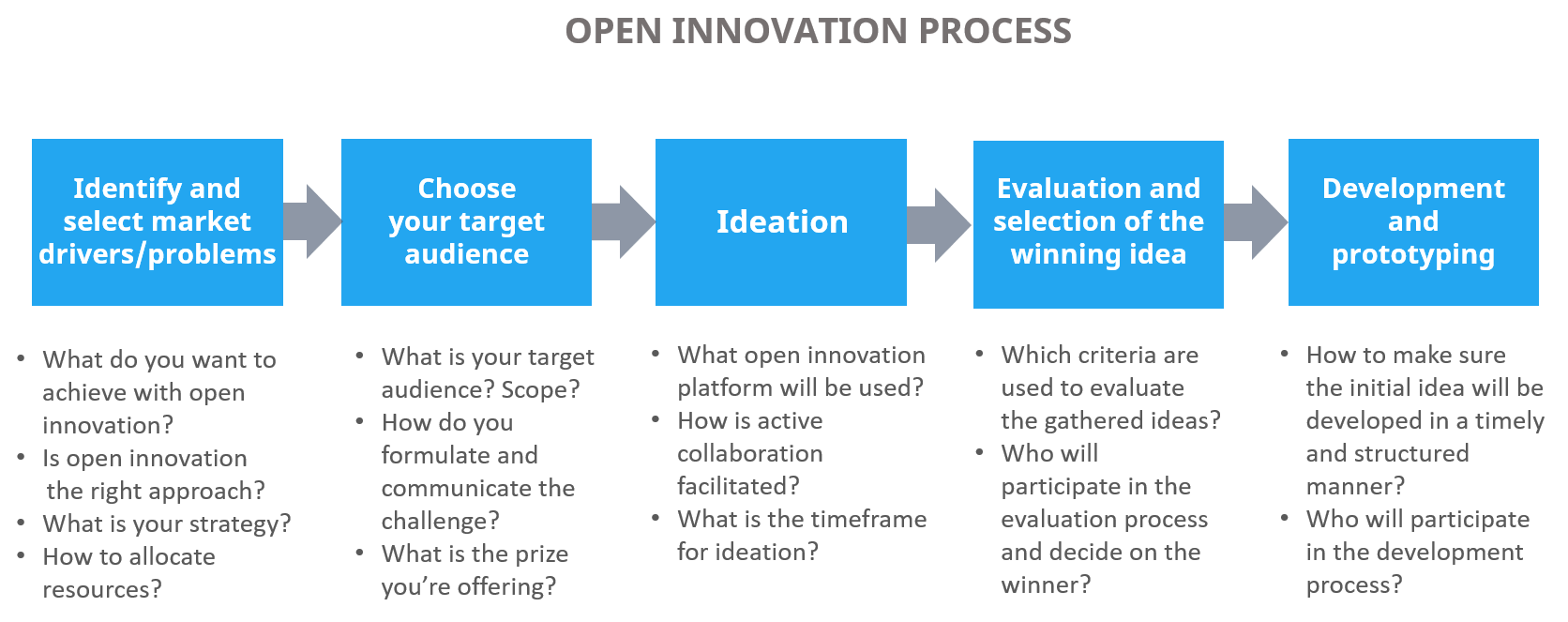Open innovation challenges – How to overcome the most common ones?
The popularity of open innovation doesn’t come as a surprise as the use of external sources can expand the innovation potential of an organization.
In fact, according to PwC’s global study of 1200 executives, over 60 % of respondents are embracing open innovation to generate new ideas.
Organizations use open innovation to access more diverse source of ideas and talent with little investment to create value they wouldn’t necessarily be able to create by themselves.
.jpg?width=800&name=andrew-palmer-255418-unsplash%20(1).jpg)
The goal for many is to find opportunities to solve unmet needs with the help of the right partnerships.
Although there are many successful examples of open innovation, innovation in general has a lot of unknown areas and risks, and open innovation isn’t any different.
While some of the risks cannot be predicted, and therefore avoided, there are some challenges organizations face more frequently than others.
Identifying and properly addressing these challenges early on can help you to avoid costly mistakes and unnecessary hurdles in the future.
In this post, we’ll look at these open innovation challenges and give our take on the subject to help you tackle some of the most common ones.
Table of Contents
Challenges and risks of open innovation
Making sense of a big pool of ideas and developing the most promising ones is only the tip of the iceberg. As we know, ideas alone aren’t worth much if not executed properly.
Therefore, the most frequently occurring challenges of open innovation aren’t necessarily related to the ideas themselves, but rather how these ideas are gathered, managed and implemented.
The most common challenges of open innovation can be divided into four categories: strategic, operational, legal and cultural aspects.

Strategic challenges and limitations of open innovation
Although open innovation is a great way to gather ideas from outside the organization to create better (and cheaper) solutions for customers fast, integrating external partners to your innovation process should be carefully planned and executed.
Surprisingly often companies that aren’t capable of innovating internally, rely on external sources of open innovation in the hopes of becoming more innovative.
There are certainly some companies that are treating open innovation as an entirely separate unit. These types of organizations are keeping themselves busy with different kinds of open innovation projects but often fail to integrate them to the big picture.
This is a problem especially when there’s no clear innovation strategy, nor internal processes and models in place for managing it. It’s more challenging to manage a collaborative process with external partners than it would be if solely done within the organization.
"Open innovation is not about outsourcing R&D to somebody else. It's really all about leveraging and enhancing your internal capabilities."
– Henry Chesbrough
Unclear goals
There’s obviously no point using open innovation just for the sake of it, which is why the most important step in starting off the whole open innovation project is to define what you want to accomplish with it.
Questions like for which purpose is open innovation used for and what is the scope of the project need to be answered to be sure open innovation really is the right tool for the job.
To do that, take a look at different types of open innovation and assess which approach would be the most suitable for you.
For example, if you have difficulties finding young professionals to your team, open innovation might be a good way to attract them. In this case, your open innovation goal could be for example to hire a number of talents who are about to graduate.
Once you’ve defined your objectives, prioritize them and stay focused.
Wrong type of audience
Another strategic challenge of open innovation is the selection of right types of partners to collaborate and pursue your goals with. Be it your existing networks, customers or completely external units, finding the right audience can help you to access information you normally wouldn’t.
![]()
Aim for targeting audiences that are willing to offer that type of knowledge you need to make your project successful that you wouldn’t necessarily be able to find within your organization.
Just like in any other process, the right partner will be found through evaluating a set of potential options. Before choosing your audience, identify the most important criteria and define the ideal scope of the audience.
For example, if you’re goal were to find young talents that are about to graduate, you would probably want to start with targeting universities.
Keep in mind that often a handful of right people is a much better option than a larger crowd of people who might not necessarily have the right competence for the job.
Diminishing returns - opportunity cost
Searching for valuable ideas and knowledge outside the organization inevitably increases both internal and external coordination costs and risks. Whatever choices you make, there's always an opportunity cost that needs to be considered.
In the beginning of an open innovation project, your results and benefits are likely to be better compared to if you’d innovate solely by yourself.
Ideally, engaging external partners to collaborate with your R&D will maximize your returns in the beginning of the project with low cost. As you get more people to collaborate with you, you’ll also maximize your chances of attracting a larger pool of potential talent or gathering promising ideas.
At some point, however, the law of diminishing returns comes to picture. It’s unlikely you’ll keep constantly getting the same amount of input as you would in the beginning of your open innovation project.
Apps of Army
Let’s look at the diminishing returns and opportunity cost through an example of the US Army that used open innovation for product development purposes.
In 2010, US Army launched the ‘Apps of Army’- contest for military and civilian members to help the army speed up its development of mobile software applications.
During the 75-day contest, 140 people engaged in the project and over 50 web and mobile application were developed by the deadline, of which 15 winners shared the cash prize.
Not bad.

If, however the contest would have lasted twice as long, the US Army most certainly would not have received double the amount of ideas. Their goal was to move fast and the more ideas they would have received, the more time they would have needed to spend on assessing these ideas.
The challenge here is to decide where to draw the line and how much input is enough before the process starts to slow down if the organizer isn't investing enough in facilitating and activating the community. For this reason, open innovation projects are often limited to a certain time-frame.
Open innovation itself isn’t a strategy, and without a strategic approach to innovation, the risks are higher and failed opportunities may result in wasted ideas and time as well as unnecessary costs.
Therefore, the strategic fit, as well as goals and audience of open innovation must be assessed and chosen thoughtfully before engaging in open innovation.
Operational and structural challenges of open innovation
As already mentioned, the more difficult part of open innovation is to decide on how to execute open innovation than it is to actually kick off the project.
The transformation from a company that is used to just innovating in-house into a company that openly innovates with third parties, requires a lot of changes on both the operational and the structural levels.
Because open innovation is a complex field with many moving parts, it’s almost always necessary to rethink your current ways of working to be able to apply open innovation successfully.
Building an effective process
The point of open innovation is to improve the quality and speed of development. Successful results tend to follow a systematically executed process. Also, to be able to make sense of the mass of information, a solid process is necessary.
An effective open innovation process integrates your own R&D, finance, manufacturing and marketing into one ecosystem you’re collaborating with.
When it comes to building an effective process, the most common challenges are lack of goals, unclear communication, lack of stakeholder support, immeasurability and lack of strategy alignment.
To make a process work, it should be aligned with organizational goals and strategy and communicated clearly to everyone involved. For your process to be successful, it’s important that all of your key stakeholders are engaged to it.
In addition, companies often underestimate how much change management is actually needed. They tend to rely too much on technology in a sense that they fail to realize that the process is really what makes or breaks the open innovation project, not the tool used for the job.
Developing and implementing ideas
According to Henry Chesbrough, the creator of the theory of open innovation, one of the challenges organizations face is that the ideas tend to stay inside the organization and aren’t developed further.
It can be challenging to find an effective way to make sure that the ideas in the development pipeline move in a timely and structured manner.
Most companies face challenges especially with:
- Prioritizing ideas - How do we decide which ideas are worth proceeding with?
- Team capacity - Who is going to be responsible for the progress of the ideas?
- Resources - Are there enough resources and how to allocate them?
- Other ideas- What are we going to do with all of the other ideas that are good but cannot yet be implemented?
When it comes to gathering, developing and implementing new potential ideas, keep the aforementioned questions in mind. To make better sense of this complex field, it’s smart to use technology.
Finding the right open innovation platform
Because you want to gather diverse ideas regardless of time and place, technology platform comes in handy.
Often, the best solution for managing open innovation projects is a dedicated open innovation platform where internal and external stakeholders can participate in ideation and open collaboration.
 Good open innovation platforms increase both the speed and the quality of the process. It guides development and follows the progress of the ideas, allowing people to collect and develop ideas transparently.
Good open innovation platforms increase both the speed and the quality of the process. It guides development and follows the progress of the ideas, allowing people to collect and develop ideas transparently.
The real challenge is how to find the right open innovation platform as there are several great options available.
Ideally, an open innovation tool is:
- Engaging
- Easy-to-use
- Transparent
- Flexible
- Adaptable
- Customizable
We’ve compared different innovation management tools in our previous post.
While in the worst case scenario, using a weak innovation management platform might lead you to failure, a good open innovation platform can be a great help when turning ideas into actual innovation. However, the success of your open innovation project really comes down to the right process.
Keep in mind that building an open innovation process that works most definitely requires a few iterations. Only after some time you’ll really know what it takes for it to be able to work in practice, so be patient.
Legal challenges of open innovation
Overlooking legal aspects can cause unnecessary hurdles if not thought through already in the beginning of an open innovation project.
These aspects are nothing magical nor difficult, but if they aren’t considered and handled in a professional manner in the start, the risks and possible negative impacts will not only affect your open innovation project but can harm your brand image as well.
Intellectual property rights (IPR)
When it comes to new ideas, inventions, designs and prototypes, intellectual property rights are more or less always on the table. Intellectual property includes patents, trademarks and copyrights that gives the creator exclusive rights to certain aspects of the innovation.
The purpose of intellectual property law is to ensure the inventor has the right to be recognized and profit from their innovations.
Often, the submitter of an innovation must assure that their innovation isn’t patented and give consent to the organization to have all the rights to develop and implement the innovation. This, however, doesn’t mean you'd have to be constantly worried about legal stuff if you openly communicate what purpose the ideas will be used for. Successful open innovation benefits both parties and is fair for everyone.
Terms and conditions
Although open innovation projects should always be built on mutual trust, carefully developed terms and conditions can help eliminating unnecessary uncertainty.
One part of terms and conditions is to clarify how ideas are handled, and whose property the ideas are after they have been submitted.
Usually, the intellectual property rights and protection apply to theories and ideas, or anything that has not been captured in a fixed medium, such as open innovation platform.
If you’re using an open innovation platform to gather ideas, the platform usually has built-in terms for transferring the rights to submitted ideas if not agreed otherwise.
For example, if you’re using Viima, all users have to accept the terms and conditions that give permission for the customer to use the content as they like, which is why it’s not necessary to write separate agreements considering the ownership of ideas.
As long as you’ve checked that the terms & conditions are as they should be, there’s no need to worry about them afterwards.
If you’re unsure of how the legal matters are or should be handled in your case, you can always turn to your vendor or legal department for more information.
Cultural challenges of open innovation
The last, but probably the most critical, challenge of open innovation is the lack of collaborative, cross-functional company culture.
Often, people may have a fixed, “this is how things are done here”-mindset. This type of culture might be problematic if people aren’t committed to executing ideas that are coming from outside of the organization.
This skepticism towards even great ideas may lead to a situation where these ideas will not be given a chance and no resources will be allocated to the development of these ideas.
Negative attitudes towards open innovation
Sometimes, an issue that limits open and innovative culture can be a negative attitude towards something that wasn’t invented in-house. More often than not, people who are against open innovation and collaboration, are afraid of quality issues. Although these types of worries are understandable, they aren't relevant to what you're trying to achieve with open innovation.
The challenge and a general misconception when it comes to open innovation is that you only have to gather good ideas. While no one would submit bad ideas on purpose, the point of open innovation is not to try to control the quality of ideas.
"The way to get good ideas is to get lots of ideas and throw the bad ones away." – Linus Pauling
Instead, the point is to get new ideas from people and leverage that knowledge. In the beginning, its nearly impossible to know which ideas are good and which ones aren’t.

Therefore, it’s important to try to change negative attitudes towards open innovation early on because if not, negative attitudes can result in inflexibility, which is completely opposite to the whole ideology of open innovation.
Sometimes, negative attitudes towards open innovation can also originate from uncertainty. Perhaps the internal team feel that their position is threatened, or simply just aren’t truly aware of the real benefits of co-creation.
In these types of situations, one way to try to change negative attitudes is to give positive examples of open innovation. People find real life success stories inspiring and if you can prove that a similar company has succeeded with their open innovation efforts, you might be able to convince your employees to give it a go.
Instead of being threatened by the new knowledge and variety of perspectives, try to find ways to embrace open company culture at all levels of your organization.
Lack of commitment
Another challenge many organizations face is the lack of motivation and commitment to open innovation projects.
Some organizations are mistakenly just observing participants but not really facilitating the collaboration. Motivation can drop at any level of the process, which is why it’s important to keep constant focus on enhancing and rewarding engagement.
But how do you actually do that?
- First, to avoid or cure demotivation and lack of commitment, take a look at your open innovation task or topic. Is the task in question interesting and challenging enough? Are the key questions related to your project open ended but specific enough?
If not, it might be a sign that people won’t necessarily find the topic interesting enough to commit to it.
- Second, to enhance engagement, take a look at you open innovation platform.
Does it encourage and reward active participation? Can participants see the progress of their ideas? Is it easy and fun to use of do they find it difficult and time consuming? - Last but not least, as already mentioned, one cannot stress enough the importance of facilitating active collaboration as it may have a huge impact on commitment.
Rewarding and motivating participants
The best way to change behavior is to reward it. If you want to enhance motivation and commitment, pay attention to your rewards and assess whether the rewards are motivating enough and aligned with what your target audience really values.
The best way to change behavior is to reward it.
This doesn’t always have to mean monetary rewards. Sometimes simply just giving recognition is enough for some to be willing to participate and keep them engaged in the project.
Sometimes people might be exited to collaborate with a specific organization to learn new things. Others, on the other hand, might already know a lot about the topic but haven’t had the chance to participate in real projects or access real data they find interesting.
Netflix, for example, challenged people to develop the algorithm so that it would give users better movie suggestions based on their activity. People were excited to contribute to developing Netflix’s algorithm because for them, it was a cool project to be a part of and they had a chance to work with interesting data.
Invite participants to the idea development process
Depending on your individual case, you might want to consider inviting the submitter of the initial idea to be a part of the implementation process as well.
Often the person who has submitted the initial idea may have some valuable opinions and knowledge about how to proceed with it. Perhaps the person has already made some research and is keen on developing the idea, which is why including that person to the whole process might be a smart thing to do. This can be highly rewarding for you, and for the participant.
Conclusion
Open innovation is a great way to access diverse sources of new perspectives and ways of thinking. By working with external partners, you’ll increase your chances to improve your innovation efforts.
Although open innovation has become a popular way for different sized organizations to innovate, there are also some challenges organizations face when implementing open innovation. The most common ones are related to either strategic, operational, legal or cultural aspects.
When planning an open innovation project, a good starting point is to assess what you want to achieve with open innovation and set clear goals. Don’t separate open innovation from your strategy but aim for aligning it with your organizational objectives.
Most importantly, make sure that you’re working with the right type of partners. To ensure everything runs smoothly, build a process for gathering, developing and implementing new ideas and keep improving your process when you learn how it works in practice.
"Companies have too much focus on ideas. The right order for successful innovation is people first, processes next and then ideas."
– Stefan Lindegaard
The earlier you’re able to identify and address open innovation challenges and risks, the less time you’ll have to spend on fixing issues. Less hurdles means more innovation!
If you keep these things in mind, I believe your open innovation project has a pretty good chance to succeed.
If you are ready to start your open innovation journey you should take a look at our Open Innovation Board designed specifically to manage your open innovation initiatives in a user-friendly, intuitive and efficient manner. You can sign up for free and start collecting and developing the most promising ideas right away!
This post is a part of our Open Innovation blog series. In this series, we dive deep into the different areas of open innovation and cover the aspects we think are the most important to understand about open innovation.
You can read the rest of the articles in our series covering open innovation by clicking on the button below. Don’t forget to subscribe to our blog to receive updates for more of our upcoming content!








